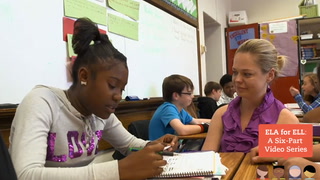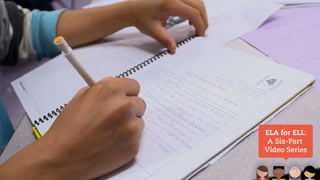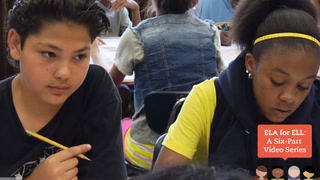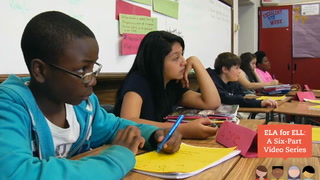Preparing Learners: Ethos, Pathos & Logos Final Program Transcript
Langlois: We're gonna move now into another section of the unit about persuasion. So what was the first section that we talked about as far as persuasion? What were we analyzing?
Student: Um, ads.
Langlois: Yeah. We were analyzing advertisements and how persuasive they were.
Langlois (INT): My name is Katie Langlois and I teach seventh grade at Morey Middle School. It's an urban school and I teach 7th grade Language Arts and often times those kids are English language learners.
Aida Walqui : Many times teachers think that students need to be grouped homogeneously. And that really runs counter to what we know about second language development. Second language development works best when you have groups that are heterogeneous because that allows teachers to both sometimes group students in more homogeneous ways and sometimes group them in more heterogeneous ways. So in the video you see that there are not only English learners but there are some speakers of African American vernacular English. In both cases and even in the case of Anglo students there is the opportunity to pull differential strengths together for the benefit of the joint work.
Langlois: Now we're going to look at thee different, um, they're called three different appeals. And they're three different ways that people can persuade people to do something, whether through advertisements or speech or writing.
Aida Walqui : This lesson is intended for students to understand that a text does not only really appeal to students' sense of logic or to the listener or the readers' sense of logic, but there are also intentional actions by the speaker or by the reader to appeal to a persons sense of ethics or doing as those you value do.
Langlois: Every group is going to be getting three strips. On these strips are three words. The words are ethos, pathos and logos. I want one person in each group to read the definition out loud. You have one minute.
Student: A pathos-driven speech or document is based on emotion. The goal is to use language or images to evoke an emotional response in the audience.
Student: Logos come from the Greek word for reason. A logo driven speech or document is based on logic or reason.
Student: Ethos comes from the Greek word for character, but a more modern translation might be image.
Student: The writer appeals to reader's sense of fairness and relies on statements that refer to fairness, morals, values and ethics.
Aida Walqui : You see in the video that students first understand what these three appeals are but the way in which it is done is in a jigsaw so that dyads of students read the appeal to logic, logos; other groups read the appeal to emotion, pathos, and some others read the appeal to ethics, ethos.
Langlois (INT): Today we moved into Aristotle's three appeals: ethos, pathos, and logos. And they analyzed those with a graphic organizer.
Langlois: You're going to use this graphic organizer to help you further analyze the three appeals.
Langlois (INT): So the graphic organizer asked them to, uh, give a one-sentence summary of the appeal. It asked them to give an example in advertising that uses one of the three and it also asked them to talk about what English words are derived from ethos, pathos, and logos.
Student: What is the der-- derivation of this word. What are some words in the English language that come from this term? So ethos, like, uh, ethics or ethical.
Student: So for the first box we wrote, this is based on reputation, values, credibility and moral character.
Langlois: Can you think of an example of an advertisement that uses ethos? That uses character? Like a Gatorade ad, where there's an athlete who's like, you should drink Gatorade. How does having an athlete sell it make it ethos?
Student: Like, he's fit, and if he's doing it then you should probably too and then you'll be fit.
Langlois: Exactly.
Student: Or pathos. Like those, uh, animal commercials.
Langlois: That's a great example of pathos. I think you're not human if you watch those and you're like, oh, this is nice.
Student: My mom sat through one once and she was like, I'll never do it again. She was like crying.
Langlois: Yeah. They're really-- I think that's a great example for that one.
Student: Logos is having reason and logic to persuade. So it's more like facts, so like, maybe a campaign commercial for, uh, a president. And they say, maybe, like, what do you guys think?
Student: Medicine commercial. That could work.
Student: They [?] to the world and get people to call in about their medicine, medications.
Student: That's more like, like, uh, reputation.
Student: Yeah but this is, they're giving reasons.
Student: Yeah. Reasons to buy it.
Student: Sometimes they give reasons why you shouldn't buy it, because you'll have these side effects. And this is why you do have, why you should buy it. 'Cause you need it.
Student: Side effects on a medicine commercial.
Langlois: Every group should have one of these, um, papers on their desk. These are kind of sample, generic advertisements.
Langlois (INT): So once they kind of had an understanding of what those three appeals were, they were given sample advertisements and they had to, as a group, decide, um, which appeal was most prominent in those sentence strips. Either ethos, pathos, or logos.
Aida Walqui : In triad each student really knows much more deeply about one appeal but also knows about the two other appeals from having listened to their peers and having taken notes in their graphic organizer.
Student: …Don't worry. You will no longer feel left out of the conversation in the hallway or worried about talking in public. You will have the courage to speak your mind without fear. Buy fresh-mouth gum and you will become the popular kid in school. I think it's this one.
Student: I think this is logos.
Langlois: Why?
Student: Because it's trying to back their product up with, by using logic.
Student: I think it's more like pathos, like, oh, are you a loser?
Student: I think it's both. I think it's both because they're trying to help you with having bad breath and you're feeling emotional about yourself 'cause you don't want to have that.
Student: They're trying to back it up with logic so you can buy it.
Student: Well, all of them are ads and they're all convincing.
Langlois (INT): I was really happy with the conversations today. They were really rich.
Langlois: Does someone want to choose one of the sample advertisements and tell me what your group thought? Gabby has her hand up.
Student: So number 2. We, like, it was kind of hard, because it was like, all three of them together.
Langlois (INT): I have a lot of students who don't have a lot of academic language and in some ways, those students have really similar struggles to English language learners and I've seen this really help those students. At the end of class when we were looking at the sample advertisements, a student Jericho raised his hand and talked about his group.
Langlois: Jericho.
Student: All right. I'm-- I'm gonna choose number three because I think it's our best one. And then we said, and it says, do you suffer from extreme bad breath? Do you…
Langlois (INT): So he read the advertisement first off. He told me which appeal his group thought that the author was using most, he used specific words from the text.
Student: Buy fresh mouth gum and you will become the most popular kid at school. We said it's pathos because it says suffer, it says feel, and it says fear. And you said that's emotions.
Langlois: I think that's great. Couldn't have said it better myself.
Langlois (INT): It was on-point. He answered the question in every way that I wanted him to. It just, for me, was really indicative that one, his group understood the three appeals but two, that he was really working with his group, because he was just able to articulate what they talked about so well.
- END -















17 Comments
Katie Langlois May 3, 2018 5:54pm
kandice long Aug 1, 2016 11:35am
Beth Harmon Jul 31, 2016 6:42pm
Amanda Wheeler Mar 4, 2015 1:39pm
Shannon Weinberg Mar 3, 2015 10:31pm